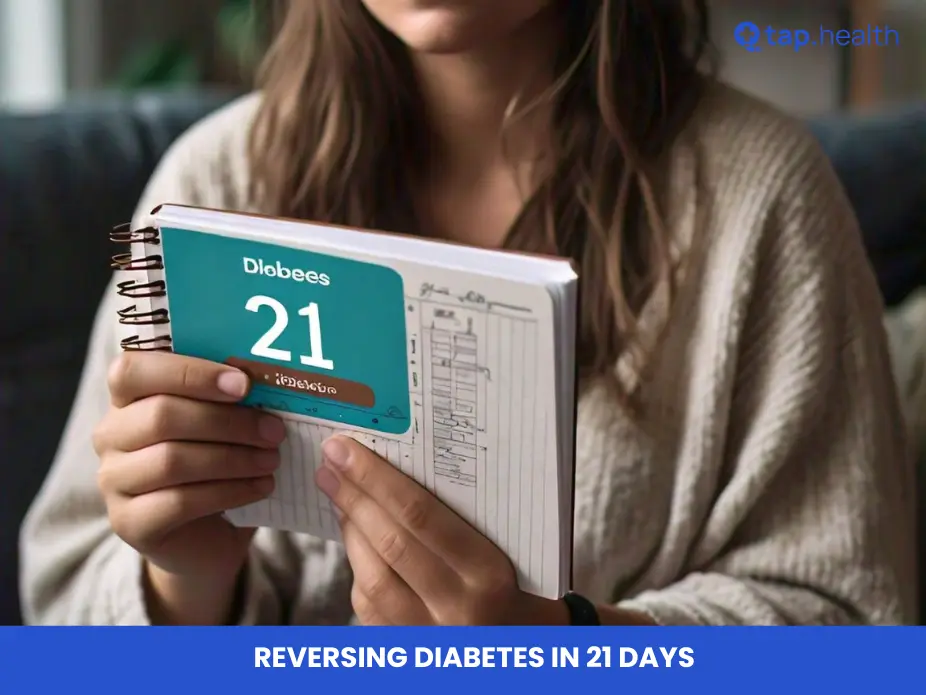Reversing type 2 diabetes in just 21 days may sound ambitious, but with a disciplined approach, significant improvements in blood sugar control are achievable. This guide explores the science behind diabetes remission, outlines a practical 21-day action plan, and provides tips for long-term success. By focusing on diet, exercise, and lifestyle changes, you can take meaningful steps toward better health and potentially reduce reliance on medications.
Understanding Type 2 Diabetes and Remission
What Is Type 2 Diabetes?
Type 2 diabetes is a chronic condition where the body either resists insulin or doesn’t produce enough, leading to elevated blood sugar levels. Often linked to lifestyle factors like obesity and inactivity, it affects millions globally. Unlike type 1 diabetes, which is autoimmune, type 2 is largely manageable through lifestyle interventions.
What Does Reversing Diabetes Mean?
Reversing diabetes, or achieving remission, involves normalizing blood sugar levels without medication. Remission is not a cure—diabetes can return if healthy habits lapse. Research, such as the DiRECT study, shows nearly 50% of participants achieved remission through weight loss and lifestyle changes within a year, though 21 days is a shorter, more intensive timeline.
Is Reversing Diabetes in 21 Days Possible?
While full remission in 21 days is challenging, significant improvements in blood sugar, insulin sensitivity, and weight are possible. Studies suggest intensive lifestyle changes, including calorie restriction and exercise, can yield rapid results. Experts like Dr. Jason Fung emphasize intermittent fasting, while Dr. Michael Greger advocates plant-based diets for better glycemic control.
The 21-Day Action Plan to Improve Blood Sugar
This structured plan integrates diet, exercise, and lifestyle changes to kickstart your journey toward managing type 2 diabetes.
Week 1: Lay the Foundation
Day 1-3: Revamp Your Diet
- Eliminate Sugary Foods: Cut out sodas, candies, and pastries to prevent blood sugar spikes. Use natural sweeteners like stevia if needed.
- Focus on Whole Foods: Fill your plate with vegetables, lean proteins, whole grains, and healthy fats. Aim for low-glycemic foods to stabilize glucose.
- Stay Hydrated: Drink 8 glasses of water daily to support kidney function and blood sugar regulation.
Day 4-7: Start Moving
- Aerobic Exercise: Begin with 30 minutes of brisk walking, cycling, or swimming, 5 days a week, to boost insulin sensitivity.
- Strength Training: Add two sessions of resistance exercises (e.g., bodyweight squats or dumbbell lifts) to build muscle and improve metabolism.
- Stay Active: Incorporate movement into your day—take stairs, walk during breaks, or stretch to reduce sedentary time.
Week 2: Build Momentum
Day 8-10: Optimize Nutrition
- Low-Carb Diet: Limit refined carbs (white bread, pasta) and focus on complex carbs like quinoa, lentils, and sweet potatoes.
- Increase Fiber: Aim for 25-30g daily from vegetables, fruits, and legumes to slow sugar absorption.
- Healthy Fats and Proteins: Include avocados, nuts, olive oil, fish, and tofu to promote satiety and support muscle health.
Day 11-14: Intensify Exercise
- Boost Intensity: Add interval training (e.g., 1 minute sprint, 2 minutes walk) to enhance calorie burn and insulin sensitivity.
- Flexibility and Balance: Incorporate yoga or stretching 2-3 times weekly to reduce stress and improve mobility.
- Track Progress: Log workouts in a journal to stay motivated and monitor improvements.
Week 3: Solidify Habits
Day 15-17: Prioritize Sleep and Stress
- Quality Sleep: Aim for 7-9 hours nightly in a dark, quiet room to regulate hormones affecting blood sugar.
- Stress Management: Practice 10-15 minutes of meditation or deep breathing daily to lower cortisol levels.
- Limit Alcohol and Smoking: Cap alcohol at one drink (women) or two (men) daily, and seek support to quit smoking.
Day 18-21: Monitor and Adjust
- Blood Sugar Checks: Use a glucometer to track levels regularly, noting patterns related to meals and activity.
- Consult Professionals: Meet with your doctor or a dietitian to review progress and adjust your plan.
- Plan for Maintenance: Set long-term goals to sustain healthy habits beyond 21 days.
Key Strategies for Success
1. Adopt a Low-Carb, High-Fiber Diet
Why It Works: Reducing carbs minimizes blood sugar spikes, while fiber slows glucose absorption, improving glycemic control.
How to Implement:
- Cut Refined Carbs: Avoid white bread, sugary cereals, and desserts. Opt for whole grains like brown rice.
- Boost Fiber: Eat vegetables (broccoli, spinach), fruits (berries, apples), and legumes (lentils, chickpeas).
- Sample Meal Plan:
- Breakfast: Spinach and mushroom omelette with olive oil.
- Lunch: Grilled chicken salad with mixed greens and vinaigrette.
- Dinner: Baked salmon, steamed broccoli, and quinoa.
- Snacks: Almonds, Greek yogurt with berries, or carrot sticks with hummus.
2. Incorporate Intermittent Fasting
Why It Works: Fasting reduces insulin levels and promotes fat loss, enhancing insulin sensitivity.
How to Implement:
- 16/8 Method: Eat within an 8-hour window (e.g., 12 PM-8 PM) and fast for 16 hours.
- Stay Hydrated: Drink water or herbal teas during fasting to curb hunger.
- Balanced Meals: Ensure meals include protein, healthy fats, and complex carbs.
3. Prioritize Physical Activity
Why It Works: Exercise improves insulin sensitivity and aids weight loss, key to diabetes management.
How to Implement:
- Aerobic: 150 minutes weekly of moderate activities like jogging or cycling.
- Strength: Two sessions weekly of exercises like push-ups or resistance band workouts.
- Flexibility: Yoga or stretching to reduce stress and improve mobility.
4. Manage Stress and Sleep
Why It Works: Stress and poor sleep elevate cortisol, worsening insulin resistance.
How to Implement:
- Meditation: 10 minutes daily of mindfulness or deep breathing.
- Sleep Routine: Maintain a consistent 7-9 hour sleep schedule.
- Relaxation: Engage in hobbies or yoga to reduce stress.
5. Monitor Blood Sugar Regularly
Why It Works: Tracking helps you understand how lifestyle changes impact glucose levels.
How to Implement:
- Glucometer: Check levels as advised by your doctor.
- Log Readings: Record meals and activity alongside blood sugar to identify trends.
- CGM Option: Consider continuous glucose monitoring for real-time data.
Overcoming Common Challenges
1. Cravings and Hunger
- Solution: Eat high-fiber foods (vegetables, legumes) and include protein and fats to stay full. Drink water to curb thirst mistaken for hunger.
2. Time Constraints for Exercise
- Solution: Break workouts into 10-minute sessions, incorporate movement into daily tasks, and schedule exercise like appointments.
3. Social Pressures
- Solution: Communicate your goals to friends, choose healthy options at events, or bring your own dish.
4. Progress Plateaus
- Solution: Vary workouts, reassess your diet with a dietitian, and set new goals to stay motivated.
5. Emotional Eating
- Solution: Identify triggers, engage in alternative activities like walking, and seek counseling if needed.
Long-Term Maintenance Tips
- Sustainable Diet: Continue low-carb, high-fiber meals with variety to ensure nutrient balance.
- Regular Exercise: Maintain a mix of aerobic, strength, and flexibility workouts.
- Ongoing Monitoring: Schedule regular check-ups and blood tests (e.g., HbA1c) to track progress.
- Stay Educated: Keep up with diabetes research through reputable sources or workshops.
When to Seek Medical Help
- Severe Symptoms: Seek immediate care for high (diabetic ketoacidosis) or low (hypoglycemia) blood sugar.
- Persistent Issues: Consult your doctor for ongoing symptoms like fatigue or blurred vision.
- Before Major Changes: Discuss diet, exercise, or medication changes with a professional.
- Regular Check-Ups: Monitor for complications like diabetic retinopathy or nephropathy.
FAQs About Reversing Diabetes in 21 Days
1. Can diabetes be fully reversed in 21 days?
Significant improvements are possible, but full remission in 21 days is ambitious. Sustained lifestyle changes are key for long-term results.
2. What does reversing diabetes mean?
It means normalizing blood sugar levels without medication, though remission requires ongoing healthy habits to maintain.
3. How is reversing diabetes different from managing it?
Reversing aims for remission without medication, while managing focuses on controlling blood sugar with lifestyle and/or drugs.
4. What are the best ways to improve blood sugar in 21 days?
Adopt a low-carb, high-fiber diet, exercise regularly, practice intermittent fasting, manage stress, and prioritize sleep.
5. How much weight loss is needed to reverse diabetes?
Losing 5-10% of body weight can improve insulin sensitivity, with greater loss potentially aiding remission.
6. Can diet alone reverse diabetes?
Diet is critical, but combining it with exercise, sleep, and stress management yields better results.
Conclusion
Reversing type 2 diabetes in 21 days is a bold goal, but significant progress is achievable with a structured plan. By adopting a low-carb diet, increasing physical activity, managing stress, and monitoring blood sugar, you can improve your health and lay the foundation for long-term remission. Consult healthcare professionals to ensure safety and personalize your approach. Stay consistent, and your efforts can lead to lasting benefits in managing diabetes.



